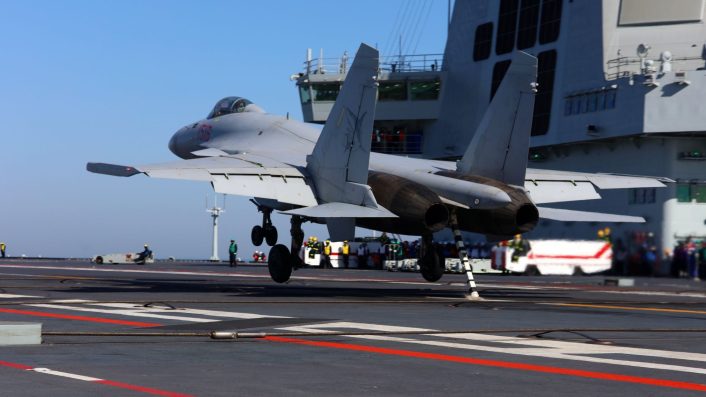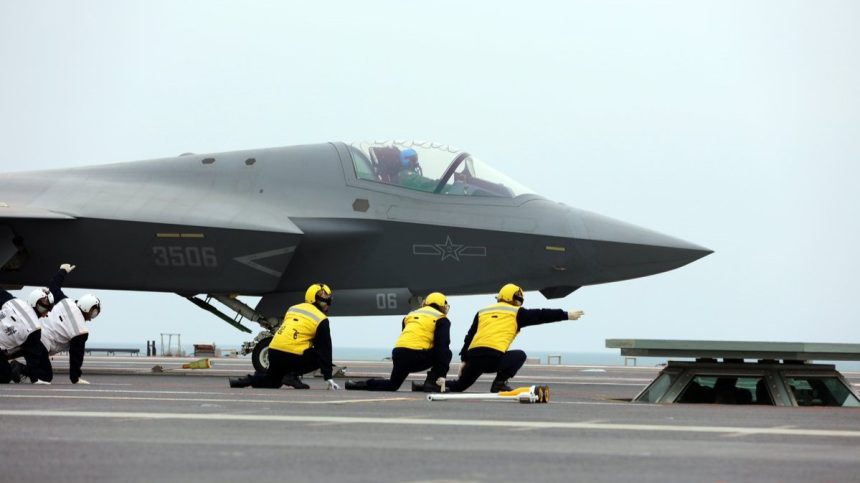China has shown for the first time its newest naval aircraft launching and recovering aboard the catapult-equipped Fujian carrier.
The PLA (People’s Liberation Army) Navy’s CNS Fujian (CV-18) carrier, an EMALS (Electro-Magnetic Launch System) configured flattop, attained a major milestone on Sep. 22, 2025. The service released images of its carrier-based CATOBAR (Catapult Assisted TakeOff But Arrested Recovery) aircraft – the J-35, the J-15T and the KJ-600 AEW&C – “successfully completing take-off and landing trials on the flight deck.”
More than one aircraft of each type were launched and recovered, the full nearly nine minute-long official footage shows. The flattop, currently is in its possibly ninth round of sea trials, after it was captured in satellite and regular images on Sep. 15 entering the Yulin naval base.
Then, on Sep. 22, Chinese military aviation researcher Andreas Rupprecht shared an pixelated image via ‘00CuriousObserver/SDF’ showing the Fujian from a distance, and observing what he concluded was a J-15. He also mentioned “rumors yesterday (Sep. 21) of various carrier based planes flying near Sanya.”
https://t.co/TgxlNVCPEU pic.twitter.com/d7ujEBMnMF
— ChinaNavy (@China_Navy) September 22, 2025
The final segment of the video shows the Fujian steaming back into port supported by tugboats, meaning these flight trials could have happened between Sep. 15 and the time the official video was released by the ‘China Navy’ account.
Three Types of PLAN Carrier-Based Aircraft Successfully Complete Takeoff and Landing Training On the Flight Deck of Fujian pic.twitter.com/GiBr4Jkcvh
— ChinaNavy (@China_Navy) September 22, 2025
Previous flight trials
This new round of trials comes after state media released previously unseen and undated footage late in July showing flight operations aboard the carrier. These may have taken place when the carrier concluded the eighth round of sea trials, as per a May 25 report by the SCMP (South China Morning Post). The carrier is expected to be commissioned by the end of this year.
First-ever official footage of flight operations aboard China’s newest, soon-to-be commissioned aircraft carrier, CNS Fujian (18)
On the eve of the PLA’s 98th anniversary, PRC media released video showcasing another major milestone: integration tests between the electromagnetic… pic.twitter.com/wIrU4hxFi6
— Ian Ellis (@ianellisjones) July 31, 2025
That footage, more of a teaser, showed a J-15T single-seat jet at least in a position for catapult launch with its afterburners engaged and the blast shield raised behind it. The shadow of the J-15T was also cast over the bow of the Fujian, suggesting two possibilities – either the jet was actually launched from the carrier or was flying overhead.
We do not know if this footage was also from the same round of sea trials. If we are to assign a PR and propaganda value to this teaser from late-July, it can be said that the J-15T’s power up was just that, and that the jet may have taken off from a land-based PLAN facility. Or, it may have taken off from the carrier, but not landed.
空母福建でのカタパルト発進と着艦訓練を行うJ-15T、J-35、KJ-600の映像 pic.twitter.com/tqRONVyWjn
— OedoSoldier (@OedoSoldier) September 22, 2025
Latest official images and videos
The latest nearly nine minute-long video clearly shows extensive footage of the full range of launch and recovery operations. This includes clips from the ‘bubble’, from the carrier, and from inside the cockpits of the KJ-600, J-35 and J-15T, taking off and recovering back on the carrier.

Also, all the three types of aircraft were launched from the catapult, with launch crews seen attaching the catapult on the launch bar of the KJ-600’s front nose wheel. This point aims to illustrate that the aircraft did not take off on their own power without the catapult. It establishes that PLAN launch, elevator, maintenance, meteorological personnel and the aircraft can now conduct the elementary mechanical and logistical procedures of launching and recovering aircraft.
Indeed, undertaking these various interlinked flying and non-flying support procedures while churning high SGRs (Sortie Generation Rates) – as is termed in Western and Indian navies – during operations while coordinating with other warships and fuel replenishment tankers during operations, is another thing. That, however, will not be unattainable for China, given it has come so far as to having three carriers.
— @Rupprecht_A (@RupprechtDeino) September 22, 2025
With the Fujian, China skipped the steam-powered catapult stage and directly developed an evidently effective EMALS system, while also developing the full-range of the ideal mix of aircraft. This includes:
- A fifth-generation navalized J-35 along with its air force counterpart the J-35A;
- A Gen. 4.5 J-15 with a standard CATOBAR J-15T (to fly from the Fujian);
- An electronic warfare (EW) jet for the STOBAR Liaoning and Shandong, the J-15DH;
- A CATOBAR-configured EW jet in the J-15DT;
- An E-2D Advanced Hawkeye equivalent in the CATOBAR-capable AEW&C aircraft, the KJ-600, for the Fujian.
Via 00CuriousObserver/SDF:
„Fujian update. We might have a plane on deck, but the picture is not clear enough to know for certain.
There were also rumours yesterday of various carrier based planes flying near Sanya.“ pic.twitter.com/ARQE7f16Hh
— @Rupprecht_A (@RupprechtDeino) September 22, 2025
On another note, we can count at least three KJ-600s based on their serials below the cockpit, with at least one of the three AEW&C aircraft captured unfolding its wings into take-off position while taxing on the upper deck.
Via ACuriousPLAFan/SDF:
The so far best images were released showing the „Fujian CV seen loitering just off Sanya, with a 056A FFL passing by in the foreground. Posted by @撒手锏_ on Weibo.“ pic.twitter.com/tRjqw7h7FK
— @Rupprecht_A (@RupprechtDeino) September 15, 2025
Other deck operations show J-35s being lowered and raised between the upper and the lower decks and a blast shield raised behind the J-35 before launch. In the final segment of the video, at least six of the fighters, including the aircraft from which the video was shot, two J-35s and three J-15Ts – two single-seat and one tandem-seat – were shown flying in formation. A cockpit video also shows a shot from inside a J-15.









